Advertisements
Advertisements
Question
When the balance point is obtained in the potentiometer, a current is drawn from ______.
Options
Both the cells and auxiliary battery
Cell only
Auxiliary battery only
Neither cell nor auxiliary battery
Solution
When the balance point is obtained in the potentiometer, a current is drawn from auxiliary battery only.
Explanation:
When a null point is obtained in the potentiometer, a current depends only on the EMF of auxiliary battery and its resistance and resistance of cells.
RELATED QUESTIONS
On what factors does the potential gradient of the wire depend?
Figure shows a 2.0 V potentiometer used for the determination of internal resistance of a 1.5 V cell. The balance point of the cell in open circuit is 76.3 cm. When a resistor of 9.5 Ω is used in the external circuit of the cell, the balance point shifts to 64.8 cm length of the potentiometer wire. Determine the internal resistance of the cell.
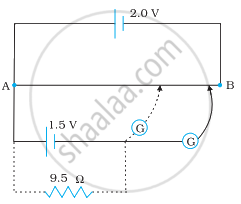
State the advantages of potentiometer over voltmeter.
SI unit of potential gradient is _______.
(a) V cm
(b) `V/"cm"`
(c) Vm
(d) `V/m`
In the given circuit, with steady current, calculate the potential drop across the capacitor and the charge stored in it.

A potentiometer wire of length 1 m has a resistance of 5 Ω. It is connected to a 8 V battery in series with a resistance of 15 Ω. Determine the emf of the primary cell which gives a balance point at 60 cm.
Figure shows a long potentiometer wire AB having a constant potential gradient. The null points for the two primary cells of emfs ε1 and ε2 connected in the manner shown are obtained at a distance of l1 = 120 cm and l2 = 300 cm from the end A. Determine (i) ε1/ε2 and (ii) position of null point for the cell ε1 only.

State the working principle of a potentiometer. With the help of the circuit diagram, explain how a potentiometer is used to compare the emf's of two primary cells. Obtain the required expression used for comparing the emfs.
Draw a labelled circuit diagram of a potentiometer to compare emfs of two cells. Write the working formula (Derivation not required).
Describe with the help of a neat circuit diagram how you will determine the internal resistance of a cell by using a potentiometer. Derive the necessary formula.
A potentiometer wire has a length of 1.5 m and a resistance of 10 Ω. It is connected in series with the cell of emf 4 Volt and internal resistance 5 Ω. Calculate the potential drop per centimeter of the wire.
Describe how a potentiometer is used to compare the emf's of two cells by the combination method.
The resistance of a potentiometer wire is 8 Ω and its length is 8 m. A resistance box and a 2 V battery are connected in series with iL What should be the resistance in the box if it is desired to have a potential drop of 1 µV/mm?
If the potential gradient of a wire decreases, then its length ______
The instrument which can measure terminal potential difference as well as electromotive force (emf) is ______
What is the SI unit of potential gradient?
State any one use of a potentiometer.
What are the disadvantages of a potentiometer over a voltmeter?
Which of the following instruments is not a direct reading instrument?
A 10 m long wire of resistance 20 Q is connected in series with a battery of emf 3 V and a resistance of 10 Ω. The potential gradient along the wire in V/m is ________.
In a potentiometer experiment, when the galvanometer shows no deflection, then no current flows through ____________.
The potentiometer is more sensitive, when ______.
The resistivity of potentiometer wire is 40 × 10-8 ohm - metre and its area of cross-section is 8 × 10-6 m2. If 0.2 ampere current is flowing through the wire, the potential gradient of the wire is ______.
Select the WRONG statement:
Two cells when connected in series are balanced on 8 m on a potentiometer. If the cells are connected with polarities of one of the cell reversed, they balance on 2 m. The ratio of e.m.f's of the two cells is ____________.
Which of the following is true for a potentiometer?
A potentiometer wire of length 100 cm has a resistance of 10 `Omega.` It is connected in series with a resistance and an accumulator of e.m.f 2 V and of negligible internal resistance. A source of e.m.f 10 mV is balanced against a 40 cm length of the potentiometer wire. The value of the external resistance is ____________.
A potentiometer is used to measure the potential difference between A and B, the null point is obtained at 0.9 m. Now the potential difference between A and C is measured, the null point is obtained at 0.3 m. The ratio `E_2/E_1` is (E1 > E2) ______

The current drawn from the battery in the given network is ______
(Internal resistance of the battery is neglected)

In the experiment to determine the internal resistance of a cell (E1) using a potentiometer, the resistance drawn from the resistance box is 'R'. The potential difference across the balancing length of the wire is equal to the terminal potential difference (V) of the cell. The value of internal resistance (r) of the cell is ______
A student connected the circuit as shown in the figure to determine the internal resistance of a cell E1 by potentiometer (E > E1). He is unable to obtain the null point because ______.
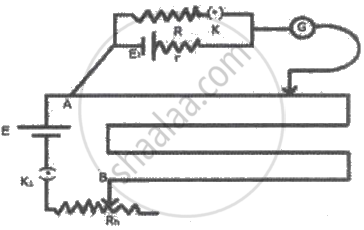
A potentiometer wire is 4 m long and a potential difference of 3 V is maintained between the ends. The e.m.f. of the cell which balances against a length of 100 cm of the potentiometer wire is ______
In the potentiometer experiment, the balancing length with a cell E1 of unknown e.m.f. is 'ℓ1' cm. By shunting the cell with resistance R Ω, the balancing length becomes `ℓ_1/2` cm, the internal resistance (r) of a cell is ______
Potentiometer measures the potential difference more accurately than a voltmeter, because ______.
In a potentiometer experiment, for measuring internal resistance of a cell, the balance point has been obtained on the fourth wire. The balance point can be shifted to fifth wire by ______.
A potentiometer wire is 100 cm long and a constant potential difference is maintained across it. Two cells are connected in series first to support one another and then in opposite direction. The balance points are obtained at 50 cm and 10 cm from the positive end of the wire in the two cases. The ratio of emf's is ______.
The best instrument for accurate measurement of EMF of a cell is ____________.
A 10 m long wire of uniform cross-section and 20 Ω resistance is used in a potentiometer. The wire is connected in series with a battery of 5 V along with an external resistance of 480 Ω. If an unknown emf E is balanced at 6.0 m length of the wire, then the value of unknown emf is ______.
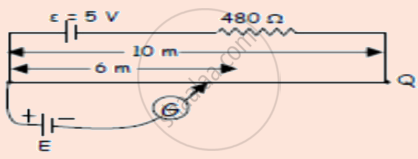
The value of current I in the network shown in fig.
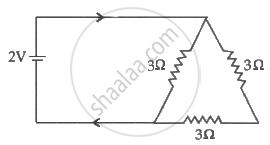
A wire of resistance R is cut into two equal part. There parts are then connected in parallel. The equivalent resistance of the combination will be
In a potentiometer circuit, a cell of EMF 1.5 V gives balance point at 36 cm length of wire. If another cell of EMF 2.5 V replaces the first cell, then at what length of the wire, the balance point occurs?
While doing an experiment with potentiometer (Figure) it was found that the deflection is one sided and (i) the deflection decreased while moving from one end A of the wire to the end B; (ii) the deflection increased. while the jockey was moved towards the end B.
- Which terminal + or – ve of the cell E1, is connected at X in case (i) and how is E1 related to E?
- Which terminal of the cell E1 is connected at X in case (ii)?
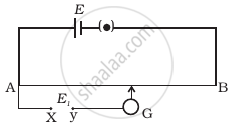
In an experiment with a potentiometer, VB = 10V. R is adjusted to be 50Ω (Figure). A student wanting to measure voltage E1 of a battery (approx. 8V) finds no null point possible. He then diminishes R to 10Ω and is able to locate the null point on the last (4th) segment of the potentiometer. Find the resistance of the potentiometer wire and potential drop per unit length across the wire in the second case.
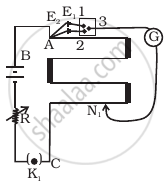
Potential difference between the points A and B in the circuit shown is 16 V, then potential difference across 2Ω resistor is ______ V. volt. (VA > VB)

A Daniel cell is balanced on 125 cm lengths of a potentiometer wire. Now the cell is short circuited by a resistance 2 Ω and the balance is obtained at 100 cm. The internal resistance of the Daniel cell is ______.
A cell of internal resistance r is connected across an external resistance nr. Then the ratio of the terminal voltage to the emf of the cell is ______.
In potentiometer experiment, null point is obtained at a particular point for a cell on potentiometer wire x cm long. If the length of the potentiometer wire is increased without changing the cell, the balancing length will ______. (Driving source is not changed)
The emf of the cell of internal resistance 1.275 Ω balances against a length of 217 cm of a potentiometer wire. Find the balancing length when the cell is shunted by a resistance of 15 Ω.
Draw a neat labelled diagram of Internal resistance of a cell using a potentiometer.
State dimension of potential gradient.
